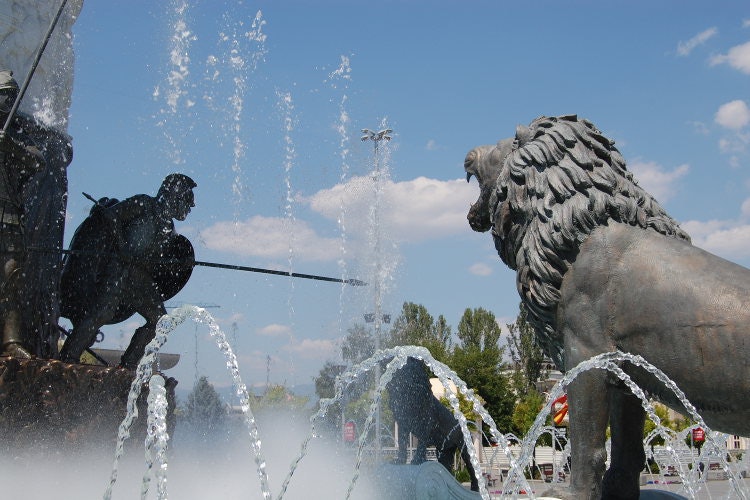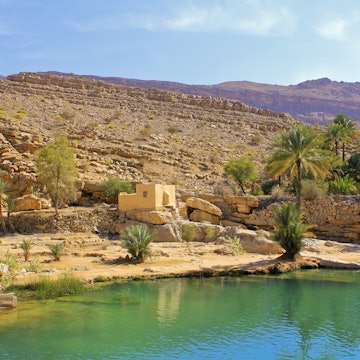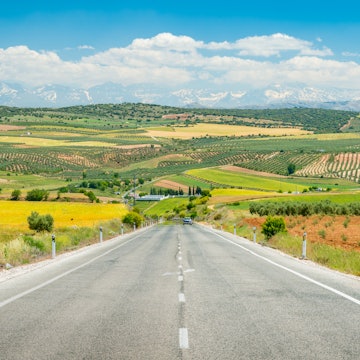

Lions and warriors are part of Skopje’s ‘Warrior on a Horse’ statue- fountain. Image by Andrzej Wojtówicz / CC BY-SA 2.0
Skopje has been through a lot lately. Whether it wanted it or not, in recent years the capital of North Macedonia has undergone an incredibly costly – and some would say slightly absurd – makeover. Take a look beyond the newly constructed, gaudy facades and eccentric embellishments though, and you will find more history, atmosphere and hospitality than you can shake a kebap at.

For a relatively poor European nation, having the government drop an estimated €200 to €500 million on a hardly necessary redesign of the capital has been highly contentious – and yet it happened. The infamous ‘Skopje 2014’ project saw the construction or remodel of dozens of new government buildings, museums and the National Theatre (not to mention a triumphal arch and two bridges) in what can be described as a mix of baroque, neoclassical and Las Vegas fashion. It also meant the installment of an excessive number of new monuments and bronze statues, with the 22m-high ‘Warrior on a Horse’ (complete with fountain and musical light show) in Ploštad Makedonija taking the cake.
The project was intended to give a boost to the national identity and bolster tourism. Though it has arguably succeeded in the latter, that might be for all the wrong reasons: Skopje’s new look overshadows the authentic attractions in what has been an important settlement for over 1500 years – and is one of the best-value city breaks in Europe right now.

Ottoman and Byzantine heritage
Settled as early as the 3rd century BC, Skopje only began to make a name for itself as an important trading centre with the rise of Byzantium and the Orthodox Christianity around the 6th century AD. This is also when the foundations were laid for Tvrdina Kale Fortress, which remains one of the city’s most impressive sights.
A stone’s throw down the hill to the Vardar River is another 6th-century relic and, for many, the symbol of the city — the striking Stone Bridge. The main pedestrian connection between the two banks of the river, the bridge also links the modern city to Ottoman Skopje and its Čaršija, the old quarter with the largest bazaar in the Balkans. As the most historic part of the town that flourished under five centuries of Ottoman rule, it’s also the most alluring with a collection of mosques, hamams and caravansarais (inns). Some of these buildings have been turned into museums and galleries, such as the National Gallery of Macedonia and Čifte Amam.
As an interesting contrast, one of the most important Orthodox churches in Skopje, the 14th-century Sveti Spas Church, is also located in this part of town; it’s worth having a peak inside to see its elaborate wood-carved iconostasis.

The earthquake legacy
The past few years are not the first time Skopje has had a makeover forced upon it. A devastating earthquake destroyed three quarters of the city on 27 July 1963; the clock on the old train station, now the Museum of the City of Skopje, still shows 5:17am – the time when the earthquake hit. Skopje was rebuilt under the authority of Yugoslavia’s President Tito and as a result, it was resurrected as a sort of modernist-brutalist paradise. Excellent examples of the architecture remaining from this era can be seen scattered around the city, but two of the more notable ones are the Central Post Office building (resembling an upside-down insect more than anything else) and the Sts Cyril and Methodius University of Skopje.
Another cultural legacy from the earthquake is the Museum of Contemporary Art, built in the years following the tragedy and probably one of the best of its kind in the region, thanks to the outpouring of donations from artists and collections from around the world. For a strangely futuristic albeit peaceful experience, pay your respects to Skopje’s most famous native, Agnes Gondzha Bojaxhiu, at the Memorial House of Mother Teresa.

Best city escapes
To see Skopje from a completely different perspective, head to Mt Vodno; it is easily reached by city bus and then a gondola ride up or, for the more active, via marked hiking paths. An incredible view of the city as well as the 66m-high Millennium Cross (the largest in the world) greets you at the top; there’s also a restaurant, gift shop and some scenic picnic areas. Not too much further afield you can admire more gorgeous views and Byzantine art at the 12th-century Sveti Pantelejmon Monastery.
Travel 15km southwest of Skopje and you will reach Canyon Matka, one of the most beautiful nature spots in the country and a great place to spend a day swimming, picnicking and exploring its caves and monasteries.

Dining and nightlife
For a capital city, Skopje has some of the most affordable dining in Europe, so make sure you take full advantage and explore what is one of the most underrated cuisines on the continent.
Macedonian menus include many of the staples you will find elsewhere in the Balkans – grilled meats (skara) are ubiquitous – but a couple of national dishes to try are tavče gravče (beans in a skillet) and pastrmajlija (fried-dough pie with dried meat).
The perfect place to try everything is Pivnica An, housed in an old Ottoman inn in the centre of Čaršija, while La Tana, on the other side of the river, is a lively, local favourite with music every weekend.
For nightlife, Debar Maalo is a happening neighbourhood with a good selection of bars, though Čaršija is where they stay open the latest (read: after midnight). Also sample the best of Macedonian wines at Vinoteka Temov, an atmospheric wine bar often featuring live guitar music.

Make it happen
Skopje’s Alexander the Great Airport has attracted low-cost flights in recent years, making it easier than ever to arrive from Western Europe. There are good bus connections from other main cities in the region such as Belgrade, Thessaloniki and Sofia, though unfortunately the same can’t be said about the trains.
Accommodation options cover all price ranges. Just off the main square, Hotel Solun boasts being the first eco-hotel in the Balkans. For the more budget-minded, Shanti Hostel is a welcoming choice and an easy three-minute walk from the bus station.
First published in June 2015
https://shop.lonelyplanet.com/products/eastern-europe-travel-guide-14












